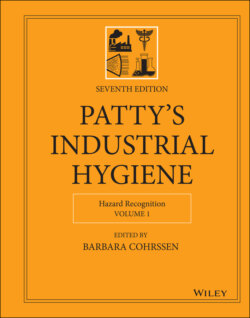Читать книгу Patty's Industrial Hygiene, Hazard Recognition - Группа авторов - Страница 113
3.1 Bow‐Tie Model
ОглавлениеEHS professionals can learn a lot in improving risk communication from the safety bow‐tie model for presenting accidents (Figure 1). In the bow‐tie model, barriers are depicted that prevent the scenario from unrolling. These barriers are the center of a safety management system. Managing these barriers is the key to successfully manage safety. The barriers on the left side of the bow‐tie are called primary barriers. Failing primary barriers can lead to a central event and can consist of failing hardware barriers or inadequate human interventions 11, 12). Supporting these primary barriers are the underlying management factors, which by failing cannot generate a central event, but determine the quality of the primary barriers. For safety, risk prevention, or exposure elimination, it is necessary to stay left of the red circle representing the central event of an accident.
Figure 1 Bow‐tie model.
Therefore, the bow‐tie is a combination of a fault tree and an event tree, linked together by a “central event.” The central event in (Figure 1 presents a state of “loss of control”; the energy content of the hazard is released and the barriers on the right side are in place to prevent the released energy from becoming an unwanted consequence like an injury or accident. As the bow‐tie was initially developed as a model for safety science, hazards like electricity or falls from heights can clearly assist in how the bow‐tie acts as an excellent risk communication model. Left‐side barriers like training and control barriers like Lock‐Out/Tag‐Out or the right fuses to prevent electrical shocks and guard rails, parapets, or the right ladder can help avoid falls from elevation. If any of these barriers fail, the release of the central event's energy does not necessarily need to lead directly to the consequences of an accident. Right‐side barriers like GFCI or surge protectors can halt the flow of electricity into a worker and fall protection devices can reduce or eliminate the adverse outcome initiated by the initial fall from elevated surfaces. Generally, scenarios leading to consequences can occur within seconds or even less. The left side of the bowtie reflects the latent condition, which can take much more time to develop, sometimes up to several years 13).
This way of presenting accidents, certainly those that lead to severe outcomes, has a major advantage for risk communications. The presentation focuses risk prevention activities for central events. Companies can pay their attention to central events they would like to avoid most, either guided by past experience, industry‐related occurrence statistics or guided by the notion that some central events will jeopardize their production. However, it is astonishing to see that most companies only have vague ideas on central events they need to avoid. Finally, the bow‐tie presentation has scenarios as its main component, either for major or for minor accidents and incidents. This difference between different types of incidents is important. It is a common belief that minor and major accidents share the same causes, or accident scenarios, and their consequences are largely governed by chance.
